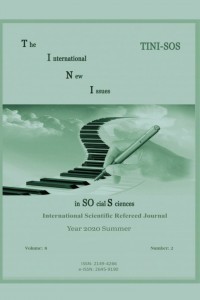AB-28 ÜLKELERİNDE ULAŞIM SEKTÖRÜ VE ULUSLARARASI TİCARET LOJİSTİĞİNİN AĞ ANALİZİ İLE İNCELENMESİ
Ulaştırma, AB ulaşım ağı, uluslararası ticaret lojistik ağı, ağ analizi
TRANSPORTATION SECTOR IN EU-28 AND NETWORK ANALYSIS OF INTERNATIONAL TRADE LOGISTICS
Transportation, EU transportation network, international trade logistic network, network analysis,
___
- Aladağ, A.E. (2016), “İstanbul Toplu Taşıma Ağı Analizi”. Conference Paper. DOI: 10.13140/RG.2.1.3256.5529.
- Arora, A. Ve Pandey, M.K. (2011), “Transportation Network Model and Network Analysis od Road Networks”. 12th Esri India User Conference.
- Barrat, A., Barthelemy, M. ve Vespignani, A. (2004), “Traffic-Driven model of the world wide web graph”. Algorithms and Models for the Web-Graph. Third International Workshop, Springer.
- Caldarelli, G. “Lectures in complex networks”, http://www.guidocaldarelli.com/images/lectures/Properties.pdf . (23.08.2017)
- Cheng, Y.Y., Lee, R.K.W., Lim, E.P. ve Zhu, F. (2015), “Measuring Centralities for Transportation Networks Beyond Structures”. Applications of Social Media and Social Network Analysis. Lecture Notes in Social Networks.
- Cheung, D.P. ve Gunes, M.H. (t.y.), “A Complex Network Analysis of the United States Air Transportation”.
- Csardi, G. Package ‘igraph’, https://cran.rproject.org/web/packages/igraph/igraph.pdf . (21.08.2017).
- Çevik, O. ve Gülcan, B. (2011), “Lojistik Faaliyetlerin Çevresel Sürdürülebilirliği ve Marco Polo Programı”. KMÜ Sosyal ve Ekonomik Araştırmalar Dergisi. C:13. S:20. 35-44.
- Çırpıcı, Y.A. ve Soyyiğit, S. (2017), “Sosyal ve Ekonomik Ağlar”. Kompleksite ve İktisat. İstanbul: Efil Yayınevi.
- Decarlo, L.T. (1997), “On the Meaning and the Use of Kurtosis”, Psychological Methods, 2 (3). 292-307.
- Estrada, E. (2015), “Introduction to Complex Networks: Structure and Dynamics”. Evolutionary Equations with Applications in Natural Sciences- Lecture Notes in Mathematics 2126. Switzerland: Springer International Publishing.
- European Commission. (2009), A Sustainable Future for Transport: Towards an Integrated, Technology-Led and User-Friendly System. Belgium: European Commission.
- European Commission. (2014), Transport – Connecting Europe’s Citizens and Businesses. Luxembourg: European Commission.
- Fagiolo, G., Reyes, J. ve Schiavo, S. (2010), The Evolution of the World Trade Web: A Weighted Network Analysis. Journal of Evolutionary Economics. 20. 479-514.
- Fuge, M. Tee K. & Agogino, A. Network Analysis of Collaborative Design Networks: A Case Study of OpenIDEO”
- https://ideal.umd.edu/papers/fuge_tee_openideo_jcise_final_2013.pdf . (23.08.2017).
- Haznagy, A., Fi, I, London, A. Ve Nemeth, T. (2015), “Complex Network Analysis of Public Transportation Networks: A Comprehensive Study”. Models and Technologies for Intelligent Transportation Systems. 3-5 June 2015. Budapest – Hungary.
- Hein, O., Schwind, M. ve König, W. (2006), “Scale-Free Networks – The Impact of Fat Tailed Degree Distribution on Diffusion and Communication Processes”. Wirtschaftsinformatik. 48 (4). 267-275.
- Howell, A. (2012), Network Statistics and Modeling the Global Trade Economy: Exponential Random Graph Models and Latent Space Models: Is Geography Dead?. University of California Unpublished Thesis.
- Kleinberg, J.M. (1999), “Authoritative Sources in a Hyperlinked Enironment”. https://www.cs.cornell.edu/home/kleinber/auth.pdf . (16.03.2017).
- Kolaczyk, E. D. (2009), Statistical analysis of network data methods and models. Springer.
- Kurt, C. (2010), Türkiye’de Ulaştırma Sektörü İçerisinde Lojistiğin Yeri ve Önemi. İstanbul Üniversitesi Sosyal Bilimler Enstitüsü İktisat Politikası Anabilim Dalı Yayınlanmamış Yüksek Lisans Tezi. İstanbul.
- Laszlo – Barabasi, A. ve Reka, A. “Emergence of scaling in random networks”. http://snap.stanford.edu/class/cs224w-readings/barabasi99scaling.pdf . (15.04.2017).
- Leon, C. ve Berndsen, R.J. (2014), “Rethinking Financial Stability: Challenges Arising from Financial Networks’ Modular Scale-free Architecture”. https://papers.ssrn.com/sol3/papers.cfm?abstract_id=2398185 . (21.08.2017).
- Lovric, M. (2010), Skewness. International Encyclopedia of Statistical Science. New York: Springer.
- Mitchell, M. (2009), Complexity A Guided Tour. Oxford University Press.
- Newman, M.E.J. (2010), Networks An Introduction.
- Newman, M.E.J. “Mixing Patterns in Network”. http://arxiv.org/pdf/condmat/0209450v2.pdf . (21.08.2017).
- OECD. (2009), Applications of Complexity science for public policy- new tools for finding unanticipated consequences and unrealized opportunities.
- Opsahl, T. ve Panzarasa, P. (2009), “Clustering in Weighted Networks”. Social Networks. 31. 155-163.
- Reichardt, J. (2009), “Introduction to Complex Networks”. Structure in Complex Networks Lecture Notes in Physics. Berlin: Springer-Verlag Heidelberg.
- Rincon, C.E.L., Machado, C. ve Paipilla, N.M.S. (2015), “Identifying Central Bank Liquidity Super-Spreader in Interbank Funds Network”. EBC Discussion Paper. Vol. 2015-010.
- Tutar, E., Tutar, F. Ve Yetişen, H. (2009), “Türkiye’de Lojistik Sektörünün Gelişmişlik Düzeyinin Seçilmiş AB Ülkeleri (Romanya ve Macaristan) ile Karşılaştırmalı Bir Analizi”. KMU İİBF Dergisi. Yıl:11. Sayı:7. 190-216.
- https://ec.europa.eu/jrc/en/research-topic/transport-sector-economicanalysis . (22.07.2017).
- http://igraph.org/r/doc/fit_power_law.html . (21.08.2017).
- https://ec.europa.eu/transport/themes/infrastructure/about-ten-t_en . (21.08.2017).
- https://ec.europa.eu/transport/themes/infrastructure_en . (21.08.2017).
- https://ec.europa.eu/info/law/better-regulation/initiatives/ares-2017- 3272163_en . (21.08.2017).
- ISSN: 2149-4266
- Yayın Aralığı: Yılda 2 Sayı
- Başlangıç: 2015
- Yayıncı: Orhan KÜÇÜK
DIŞ TİCARETİN BÖLGESEL KALKINMA ÜZERİNE ETKİLERİ: ORTA ANADOLU BÖLGESİ ÜZERİNE BİR ARAŞTIRMA
ÖRGÜTSEL GÜVENİN İŞE BAĞLILIK ÜZERİNE ETKİSİ: LOJİSTİK ÇALIŞANLARINA YÖNELİK BİR UYGULAMA
Ramazan Özkan YILDIZ, Esra BARAN, İlke Sezin AYAZ
LOJİSTİK PERFORMANSININ EKONOMİK BÜYÜME ÜZERİNDEKİ ETKİSİ
Gürkan BOZMA, Sibel İsmailçebi BAŞAR, Salih AYDIN
TÜRKİYE'DE DIŞ TİCARET VE LOJİSTİKTE YENİ FIRSATLAR VE HEDEFLER
Fehim BAKIRCI, Abdullah TAKIM, Abdullah TÜZEMEN
AFET LOJİSTİĞİ TESİS YERİ SEÇİMİ PROBLEMİ: TRA1 BÖLGESİ İÇİN BİR UYGULAMA
Osman DEMİRDÖĞEN, Hamit ERDAL, Fatma Gül YAZICILAR, Selin AYKOL
BİR İÇECEK FİRMASINDA TİP DÖNÜŞÜM SÜRELERİNİN KISALTILMASINA YÖNELİK UYGULAMA
Sevde Dilruba KARAYEL, Ediz ATMACA, Özge AKIN
LOJİSTİK FAALİYETLERDE MODERN STOK YÖNETİM MODELLERİNİN UYGULANABİLİRLİĞİ
Dilşad GÜZEL, Fatma Gül YAZICILAR, Selin AYKOL
Mustafa BAYHAN, Mevhibe TÜRKMEN
TR90 BÖLGESİ DIŞ TİCARET YAPISININ ANALİZİ
